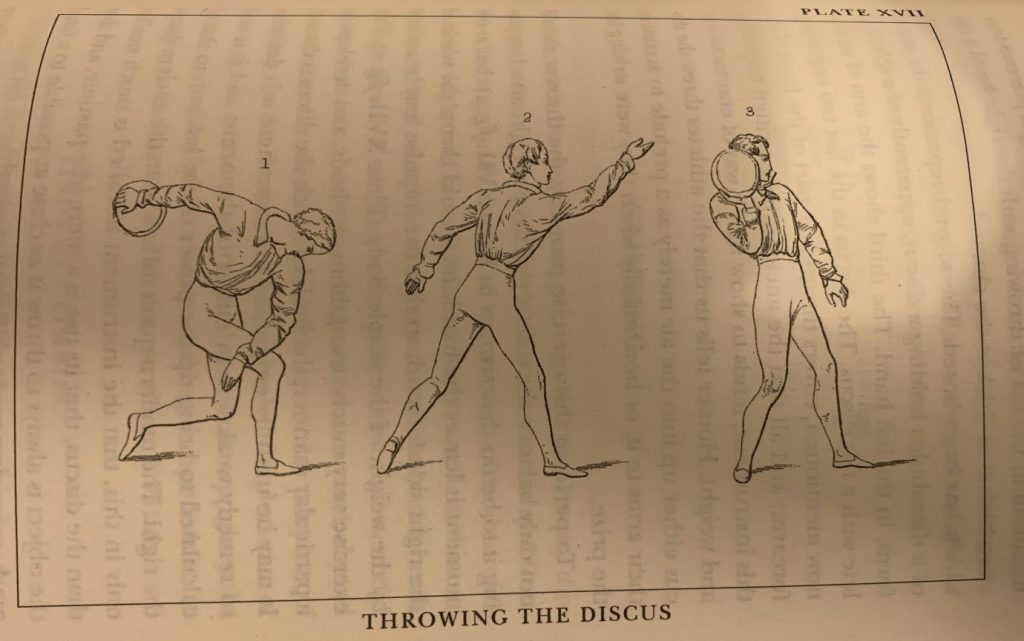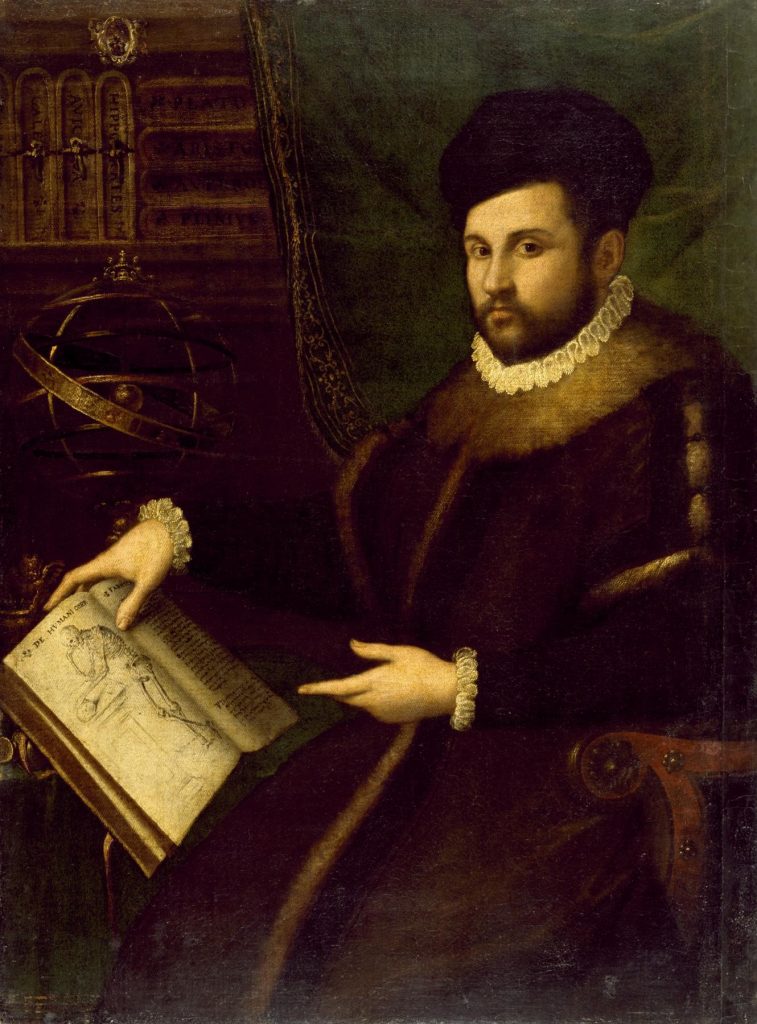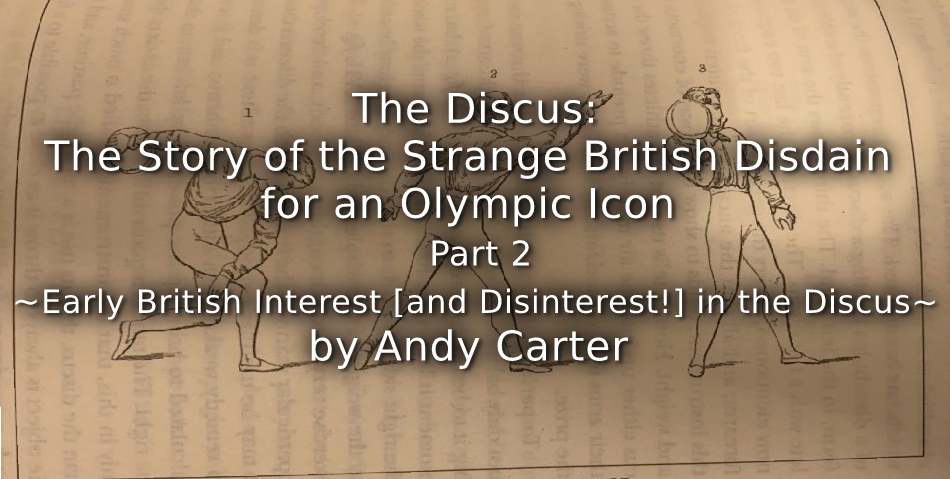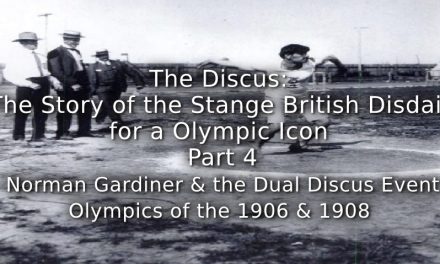In the early 1800s, fitness regimes and personal trainers were all the rage among well-to-do young men. For those who could not afford to engage their own trainer, help was on hand in the form of training manuals. These gave advice on exercises, diets and sleep, based, at least in part, on texts from ancient authorities such as Galen.
One of the most popular manuals was Walker’s Manly Exercises, written by Donald Walker in 1834. Walker was part of a fine Scottish tradition in producing books on fitness and he drew on the works of his compatriots John Gillies, Sir John Sinclair and Walter Thom for much of his information, but perhaps inspired directly by the discobolus, he unusually included a chapter on throwing the discus. Walker’s source for this information was not Gilbert West, but Girolamo Mercuriale, a sixteenth-century Italian doctor who had written the first modern study of ancient Greek athletics, De Arte Gymnastica, in 1569.

Detail from Walker’s Manly Exercises explaining how to throw the discus

Girolamo Mercuriale author of De Arte Gymnastica, 1569
Walker suggested that throwing the discus was excellent exercise and gave some estimations of how far an averagely fit young man might expect to throw one. His estimates are quite interesting as he suggests one might expect to throw a one-pound lead discus 140 feet (42.67 metres), or a half pound brick one 160 feet (48.77 metres). To put these distances in context, George Robertson, the first British man for whom we actually have a measured discus throw, managed just 25.2 metres to come fourth at the 1896 Athens Olympics. Even the gold medallist, Robert Garrett of the USA, only managed 29.15 metres, and he was using a much more athletic and mobile technique than that described by Walker.
Robertson only really threw the discus at the Olympics by accident. He went to Athens because as an Oxford-educated classicist he was curious to see the revived Olympics. He was hoping to enter the hammer, the event for which he had won a Blue. Unfortunately, there was no hammer event at Athens, so he entered the discus, a discipline he had never tried before, as the next best thing. In the circumstances, fourth position was a very creditable effort. Ironically, Robertson is less remembered for his performance in the discus, than for winning bronze in the tennis doubles, despite losing his only match after receiving a bye to the semi-final. However, his involvement in the games was completely confined to sporting failure. He also penned and performed the Olympic Ode, a rather long pastiche of the ancient poet Pindar, which he read at the opening ceremony to a bemused, and uncomprehending, audience of modern Athenians to whom his English accented, three-thousand-year-old dialect was little more than gibberish.
That no British discus throw was recorded until 1896 shows us that, although Walker suggested throwing it was useful exercise, nobody in Britain considered it a competitive event. There was an attempt to establish it in England when it was included in the Liverpool Olympic Games of 1862. The Liverpool Mercury reported that the event was won by Mr R.T. Parkinson, with Alexander Fairweather of Manchester finishing in second place, but unfortunately reports no further details of the competition. The Evening Standard gives the additional information that there were five entrants. The discus was not brought back for the second Liverpool Olympics in 1863, although Parkinson and Fairweather were back, tying for second place in the pole vault.
Neither the discus, nor for that matter the javelin, are mentioned in either Henry Fazakerley Wilkinson’s Modern Athletics in 1875 or Montague Shearman’s Athletics and Football in 1887, where the only regular throwing events mentioned are the hammer and putting the weight or shot, with references to occasional competitions in throwing the cricket ball and tossing the caber. These were all regarded as indigenous British events, cricket ball throwing was a comparatively recent English innovation, but the others had their roots in Norse games and were particularly popular on the Highland Games circuit.
Further confirmation of a lack of British interest in classical throwing events comes from John Pentland Mahaffy’s account of the 1875 Zappas Games in Athens. Although he was professor of ancient history at Trinity College, Dublin and had taught ancient Greek for many years, this trip to Athens, at the age of 46, was Mahaffy’s first visit to Greece, where he was surprised to find the locals didn’t understand a word of his British accented ancient Greek. He couldn’t understand modern Greek either, as demonstrated by his mistaking gymnastics for equestrianism in the programme of events.

John Pentland Mahaffy, Professor of Ancient History at Trinity College, Dublin
However, he was sufficiently inspired by his visit to the Panathenaic stadium to start a study of ancient Greek athletics on his return to Ireland, something which was to set in motion a fifty-year period of intense activity on ancient sport by a tightly knit group of Oxford and Cambridge scholars. Unfortunately, Mahaffy was to introduce a set of inaccurate beliefs concerning amateurism, class and race in ancient sport that his colleagues were to incorporate and build on, and these would ultimately filter through to the beginnings of the modern Olympic movement. At Athens in 1875, Mahaffy was unimpressed with the sporting prowess of the Greeks generally, and their attempts to revive the discus and javelin in particular, commenting that ‘in our sports we never throw the disk or the dart’.
Article © of Andy Carter
To read Part 3: Greek Revival and British Academic Objections -click HERE




![The Eternal Seconds of Italian Women’s Athletics:<br>The History of Gruppo Sportivo La Filotecnica [Milan, 1935-1943]](https://www.playingpasts.co.uk/wp-content/uploads/2020/07/PP-banner-maker-3-440x264.jpg)

At the 1896 Olympics they were throwing a 2k discus, 4.4 pounds, which you cannot throw nearly as far as a 1 pound disc. That would make up for the discrepancy described